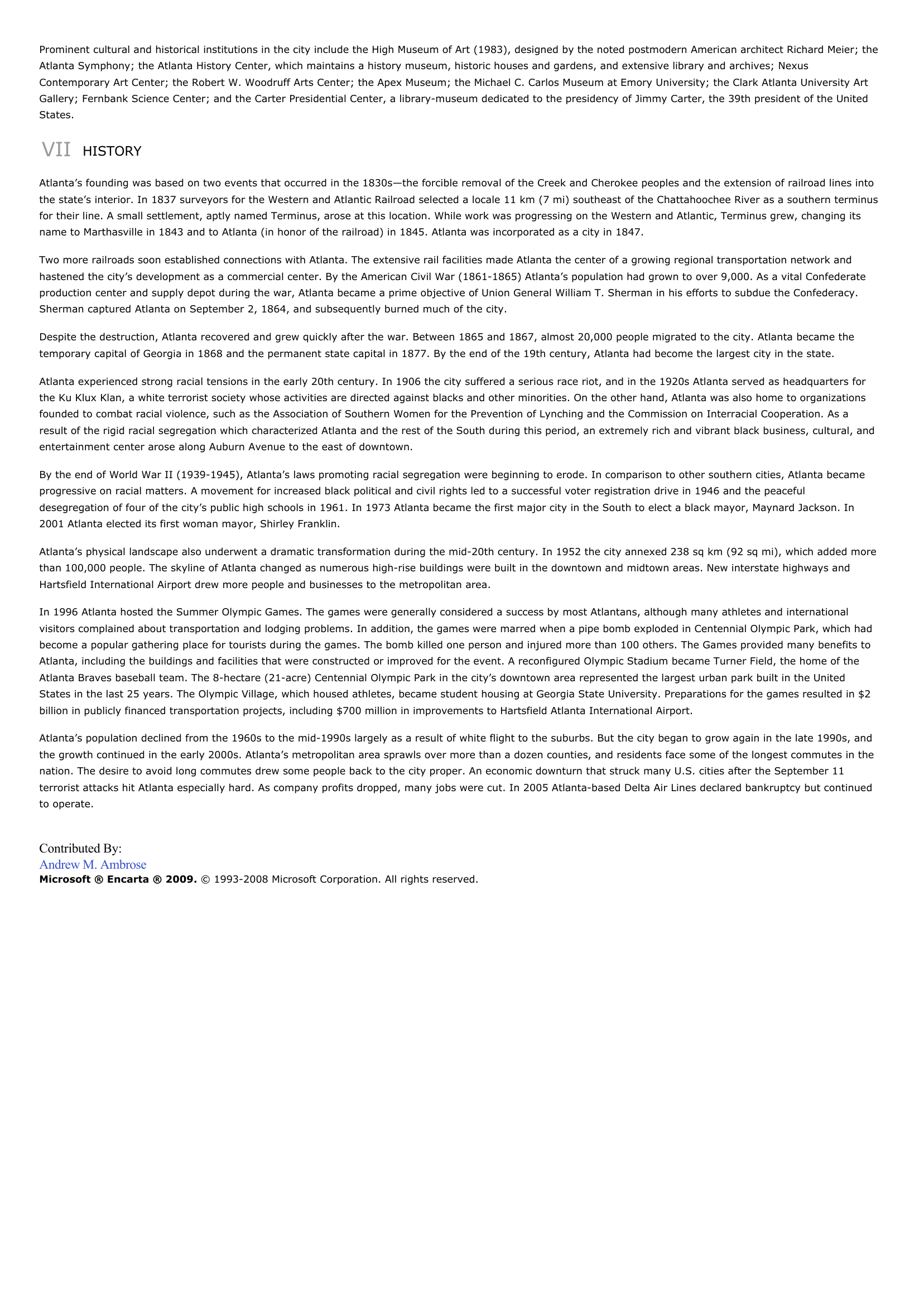Atlanta - geography.
Publié le 04/05/2013

Extrait du document
«
Prominent cultural and historical institutions in the city include the High Museum of Art (1983), designed by the noted postmodern American architect Richard Meier; theAtlanta Symphony; the Atlanta History Center, which maintains a history museum, historic houses and gardens, and extensive library and archives; NexusContemporary Art Center; the Robert W.
Woodruff Arts Center; the Apex Museum; the Michael C.
Carlos Museum at Emory University; the Clark Atlanta University ArtGallery; Fernbank Science Center; and the Carter Presidential Center, a library-museum dedicated to the presidency of Jimmy Carter, the 39th president of the UnitedStates.
VII HISTORY
Atlanta’s founding was based on two events that occurred in the 1830s—the forcible removal of the Creek and Cherokee peoples and the extension of railroad lines intothe state’s interior.
In 1837 surveyors for the Western and Atlantic Railroad selected a locale 11 km (7 mi) southeast of the Chattahoochee River as a southern terminusfor their line.
A small settlement, aptly named Terminus, arose at this location.
While work was progressing on the Western and Atlantic, Terminus grew, changing itsname to Marthasville in 1843 and to Atlanta (in honor of the railroad) in 1845.
Atlanta was incorporated as a city in 1847.
Two more railroads soon established connections with Atlanta.
The extensive rail facilities made Atlanta the center of a growing regional transportation network andhastened the city’s development as a commercial center.
By the American Civil War (1861-1865) Atlanta’s population had grown to over 9,000.
As a vital Confederateproduction center and supply depot during the war, Atlanta became a prime objective of Union General William T.
Sherman in his efforts to subdue the Confederacy.Sherman captured Atlanta on September 2, 1864, and subsequently burned much of the city.
Despite the destruction, Atlanta recovered and grew quickly after the war.
Between 1865 and 1867, almost 20,000 people migrated to the city.
Atlanta became thetemporary capital of Georgia in 1868 and the permanent state capital in 1877.
By the end of the 19th century, Atlanta had become the largest city in the state.
Atlanta experienced strong racial tensions in the early 20th century.
In 1906 the city suffered a serious race riot, and in the 1920s Atlanta served as headquarters forthe Ku Klux Klan, a white terrorist society whose activities are directed against blacks and other minorities.
On the other hand, Atlanta was also home to organizationsfounded to combat racial violence, such as the Association of Southern Women for the Prevention of Lynching and the Commission on Interracial Cooperation.
As aresult of the rigid racial segregation which characterized Atlanta and the rest of the South during this period, an extremely rich and vibrant black business, cultural, andentertainment center arose along Auburn Avenue to the east of downtown.
By the end of World War II (1939-1945), Atlanta’s laws promoting racial segregation were beginning to erode.
In comparison to other southern cities, Atlanta becameprogressive on racial matters.
A movement for increased black political and civil rights led to a successful voter registration drive in 1946 and the peacefuldesegregation of four of the city’s public high schools in 1961.
In 1973 Atlanta became the first major city in the South to elect a black mayor, Maynard Jackson.
In2001 Atlanta elected its first woman mayor, Shirley Franklin.
Atlanta’s physical landscape also underwent a dramatic transformation during the mid-20th century.
In 1952 the city annexed 238 sq km (92 sq mi), which added morethan 100,000 people.
The skyline of Atlanta changed as numerous high-rise buildings were built in the downtown and midtown areas.
New interstate highways andHartsfield International Airport drew more people and businesses to the metropolitan area.
In 1996 Atlanta hosted the Summer Olympic Games.
The games were generally considered a success by most Atlantans, although many athletes and internationalvisitors complained about transportation and lodging problems.
In addition, the games were marred when a pipe bomb exploded in Centennial Olympic Park, which hadbecome a popular gathering place for tourists during the games.
The bomb killed one person and injured more than 100 others.
The Games provided many benefits toAtlanta, including the buildings and facilities that were constructed or improved for the event.
A reconfigured Olympic Stadium became Turner Field, the home of theAtlanta Braves baseball team.
The 8-hectare (21-acre) Centennial Olympic Park in the city’s downtown area represented the largest urban park built in the UnitedStates in the last 25 years.
The Olympic Village, which housed athletes, became student housing at Georgia State University.
Preparations for the games resulted in $2billion in publicly financed transportation projects, including $700 million in improvements to Hartsfield Atlanta International Airport.
Atlanta’s population declined from the 1960s to the mid-1990s largely as a result of white flight to the suburbs.
But the city began to grow again in the late 1990s, andthe growth continued in the early 2000s.
Atlanta’s metropolitan area sprawls over more than a dozen counties, and residents face some of the longest commutes in thenation.
The desire to avoid long commutes drew some people back to the city proper.
An economic downturn that struck many U.S.
cities after the September 11terrorist attacks hit Atlanta especially hard.
As company profits dropped, many jobs were cut.
In 2005 Atlanta-based Delta Air Lines declared bankruptcy but continuedto operate.
Contributed By:Andrew M.
AmbroseMicrosoft ® Encarta ® 2009. © 1993-2008 Microsoft Corporation.
All rights reserved..
»
↓↓↓ APERÇU DU DOCUMENT ↓↓↓
Liens utiles
- Atlanta - geography.
- Mitchell Margaret, 1900-1949, née à Atlanta (Géorgie), romancière américaine.
- Lee (Shelton Jackson , dit Spike), né en 1957 à Atlanta (Géorgie), acteur et cinéaste américain.
- King Martin Luther , 1929-1968, né à Atlanta (Georgie), pasteur noir américain.
- Hardy Oliver, 1892-1957, né à Atlanta (Georgie), acteur américain.










